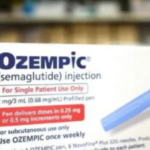
Navigating the maze of weight loss can sometimes feel like deciphering a cryptic puzzle. For many, even after ticking off the boxes of a balanced diet and regular exercise, the scale refuses to budge. The question that hangs ominously is – why? As it turns out, the answer may lie in the microscopic realm of chemicals we interact with every day.
1.Endocrine Disruptors: Picture a grand symphony, where hormones are the musicians, and our body is the orchestra. Endocrine disruptors are the false notes that throw the entire performance into chaos. They either mimic natural hormones, leading the body into erroneous actions, or block the hormones entirely, stalling vital processes. The result? Disrupted metabolic functions and, often, weight gain.
Specific Examples and Exposure:
A. Bisphenol A (BPA): Commonly found in plastic containers, water bottles, and the lining of canned foods.
B. Phthalates: Used in PVC plastics, these can be found in vinyl flooring, toys, and even some cosmetics.
C.Parabens: Widely used preservatives in cosmetic and pharmaceutical products, from shampoos to lotions.
D. Dioxins: Emitted from waste burning and certain industrial processes. They accumulate in the food chain, particularly in meat.
E. Atrazine: An herbicide that can contaminate drinking water.
2. Obesogens: These are the undercover agents, surreptitiously tweaking the body’s mechanisms. Their modus operandi involves increasing fat storage, altering hunger hormones, and even modifying the metabolic rate. This means that despite the grueling workouts and the carefully portioned meals, obesogens could still keep those extra pounds intact.
Specific Examples and Exposure:
A. Tributyltin (TBT): Found in paints and is known to contaminate seafood.
B. Phthalates: Yes, they are also obesogens! Exposure can come from plastics, cosmetics, and even some medical devices.
C.High fructose corn syrup: A common sweetener in sodas and processed foods.
D. Monosodium Glutamate (MSG): Often used as a flavor enhancer in many foods.
3.Forever Chemicals (PFAS): Named for their persistence, these chemicals neither break down nor leave the body easily. What’s alarming is their ability to interfere with mitochondria, our cellular energy factories. This can lead to decreased energy output, making workouts less effective and slowing down metabolic rates.
Specific Examples and Exposure:
A. PFOA & PFOS: Used in non-stick cookware, water-repellent clothing, and some firefighting foams.
B. GenX: A replacement for PFOA, used in making non-stick pans.
C. PFBS: Found in water-repellent fabric and carpeting, as well as firefighting foams.
Life in the 21st century, while convenient, comes packed with these invisible foes. That soft, comforting bedsheet? It might have been treated with endocrine disruptors to make it wrinkle-free. The new shoes showcasing a vibrant sheen? They might contain PFAS to make them stain-resistant. Even the water flowing from our taps, if unfiltered, can be a cocktail of these unwanted chemicals. It’s a daily dance with these silent saboteurs, often unbeknownst to us.
Knowing the enemy is half the battle won. The other half involves strategic defense and counteraction.
Unraveling the Body’s Detox System and the Role of Foods and Supplements
The body’s detoxification system is an intricate network that ensures unwanted toxins and waste products are effectively removed, ensuring optimal health and function. This system is primarily carried out by organs such as the liver, kidneys, intestines, and the skin. Certain foods and supplements can offer incredible support to these organs, enhancing their ability to detoxify efficiently. Let’s delve deeper into how each of these foods and supplements play their part.
Foods That Support Detoxification:
Protein: Proteins play a pivotal role in the body’s detoxification process. Enzymes, which are proteins, facilitate the transformation and neutralization of toxins into compounds that the body can safely eliminate. The liver, the primary organ responsible for detoxification, relies heavily on protein-derived enzymes to break down harmful substances. Moreover, proteins help in the synthesis of glutathione, a potent antioxidant and detoxifying agent in the body. Without an adequate protein intake, the body’s ability to neutralize and excrete toxins could be compromised, leading to a potential buildup of harmful substances and adversely affecting overall health.
Water: The kidneys use water to filter waste from the blood, excreting them through urine. Staying hydrated ensures efficient kidney function and helps to flush out toxins.
Fiber: Foods rich in fiber, such as fruits, vegetables, whole grains, and legumes, help promote bowel regularity. This ensures that waste and toxins are effectively excreted through feces, preventing them from lingering in the body.
Cruciferous Vegetables: Broccoli, cauliflower, Brussels sprouts, and cabbage contain compounds like sulforaphane that enhance the liver’s detoxifying enzymes. This aids the liver in breaking down harmful substances to be eliminated from the body.
Garlic: Allicin and selenium in garlic support liver function, enhancing its ability to process and remove toxins.
Green Tea: This tea is loaded with catechins, antioxidants that assist in the liver’s detoxification processes, promoting efficient breakdown and removal of toxins.
Leafy Greens: These greens are high in chlorophyll, a compound that binds to and helps remove toxins, especially heavy metals, from the bloodstream.
Beets: They contain compounds that boost the liver’s phase 2 detoxification process, where toxins are neutralized and prepared for excretion.
Turmeric: Curcumin, the active compound in turmeric, stimulates bile production in the liver, aiding in the digestion and excretion of fats and toxins.
Ginger: This root supports digestion and increases the production of digestive juices, facilitating the timely removal of waste products.
Lemons: Rich in vitamin C, lemons support the liver in converting toxins into water-soluble substances, making them easier to excrete.
Flaxseeds and Chia Seeds: Their high omega-3 content reduces inflammation, while their fiber content supports bowel regularity, aiding detoxification.
Artichokes: By increasing bile production, they promote fat digestion and detoxification.
Dandelion: Often consumed as tea, dandelion supports liver function, promoting the removal of toxins.
Supplements That Bolster Detoxification:
Magnesium: Essential for multiple enzymatic reactions in the body, magnesium also supports bowel regularity, facilitating toxin removal.
Milk Thistle: Contains silymarin, an antioxidant that aids liver function, particularly in regenerating liver cells and neutralizing toxins.
Probiotics: They help maintain a healthy gut flora balance, ensuring optimal digestion and prevention of toxin buildup.
Zinc and Selenium: Both are crucial for the function of detoxification enzymes, particularly in the liver.
Glutathione: This powerful antioxidant supports the liver in neutralizing harmful substances. Supplementation can help restore depleted glutathione levels.
N-acetylcysteine (NAC): As a precursor to glutathione, NAC aids the body’s detox pathways, especially in the liver.
The Grand Finale:
The journey towards weight loss and optimal health isn’t just about calories in and out. It’s a more nuanced dance involving the unseen, often unnoticed chemicals that influence our body’s inner workings. But with knowledge, awareness, and the arsenal of natural foods and supplements, victory in this hidden battle is attainable. Always remember to walk this path hand in hand with experts, consulting a registered dietitian or healthcare professional when making significant changes to your regimen.

The Ultimate Guide to Weight Loss Miracle Drugs: Harnessing the Power of Ozempic & Mounjaro Safely
Drop these five ingredients to lose weight and belly-fat!

